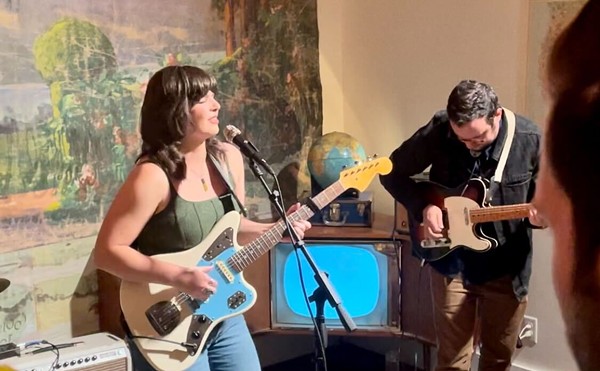But unlike the stereotypical dreadlocked technology gurus who make glorious, Utopian predictions for a digital future but seem to be juggling speculation, fantasy and lofty theoretical gibberish, Morton Subotnick has witnessed the rise of electronic music nearly from its inception in the late '50s and early '60s; it's this vision, one that stretches back to the past as well as into the future, that gives his thoughts weight. He'll be lecturing at the University of Missouri-St. Louis on Thursday, March 11, as part of Art, Design and Music in the Electronic Age, a two-day conference designed to highlight the work of pioneers in the fields.
Here's Subotnick attempting to explain the future of chamber music: "You can give someone a program like (Microsoft) Word that gives them the possibility of writing. You can now write anything you'd like. You can write letters, you can write a novel, you can do anything you want. But what if an artist with intention gives you something that is a novel or short story or the equivalent, but when you have it in your home it can actually be reacted to and altered -- not by you rewriting it, but in a malleable kind of way. And I'm thinking of this in terms of chamber music, where work can respond to the viewer -- where a viewer can make certain kinds of conscious choices, but they can also make gestural or responsive (movements) -- physical, maybe, but down the line it could be microphones or sensors of some sort. A work that can read your response to what's going on, much like a performer in a chamber-music situation responds to the audience. But it can go beyond simply little changes; it can be anything from small to major things, so that a work becomes, over a period of time as the viewer looks at it, like The Picture of Dorian Gray, almost a narrative, because the narrative aspects of the piece that attract a particular person to it gradually turns into that. It sounds like science fiction, but that's actually possible, but you can't describe it because it's never happened before. That's what excites me about it; there's a whole new avenue that's possible for truly a new medium, a new art form, to happen."
Subotnick is no stranger to new media; in 1967 he almost singlehandedly introduced America to electronic music -- though Karlheinz Stockhausen had been working in the medium for more than a decade in Germany -- with his composition Silver Apples on the Moon (named after a line from W.B. Yeats' "The Song of Wandering Aengus"). It was a revolutionary work for a number of reasons, some of which were intentional, some of which were the result of the ways in which artists since its release have harnessed those ideas.
"The first big record, the big hit," says Subotnick of those early years, "was in 1967, I think. It was the same year Silver Apples came out. It was called Switched on Bach (by Walter Carlos). That was the big hit, and that was on a Moog synthesizer. Silver Apples came out a few months later. Silver Apples is certainly a good piece, and all those pieces were good and certainly unique; they still are. But I think part of the success was that the moment was really ripe. It was nothing that I did on purpose; it just happened that I was just on the edge of where everything was going at that moment. I was introducing electronic music to people. Nobody had heard of electronic music, and I would go into a classroom or a small auditorium in, say, the middle of Kansas in 1967, and people would say, 'Oh, I love electronic music.' And I'd think, 'This is odd, what have you heard?' And they'd say, 'Well I've only heard one piece, Switched on Bach.'"
Silver Apples of the Moon is a freaky piece of music; its synthetic, layered tones are both playful and controlled. The piece, recorded for LP and thus divided into two "movements," moves from solid, single-toned ambience to chirpy R2D2 sounds, from beep-lines to synthetic screams; imagining hearing the piece when it was released more than 30 years ago, and the confusion that it must have inspired in the listener, is easy, because it remains just as curious when heard today.
Within five years of Silver Apples' release, electronic music would branch out in a number of different directions: on one side, crazy pop-oriented Moog albums interpreting the music of Hendrix, the Beatles, the Stones and Simon & Garfunkel with hilarious but fantastic results; on another, serious-minded composers working in the medium of "fine art" music and creating unique new compositions. Somewhere in between -- and where Subotnick unintentionally inspired musicians -- were experimental pop outfits like the Silver Apples (named after his composition), whose early-'70s debut sounds much more dated than Subotnick's. And in the last five years countless artists and bands have expressed admiration for his early work, including Stereolab, Beck, Tortoise and Laika (who named their recent release Silver Apples of the Moon, a direct homage to its predecessor). And without Subotnick's pioneering work, the genre now known as electronica would undoubtedly exist in a different form.
Since then, the composer has remained on the edge of the technology, releasing more than a dozen compositions harnessing the latest advances; in the past decade he has directed his attention toward compositions for CD-ROM. "The speed, depth and economy of the computer," he says, "has given us a major form of random-access technology where you can create things that are not necessarily linear. Like CD-ROM -- I've done a lot of work in this, and some of it was inadvertently pioneer work. It's one of the things that I'm going to be talking about in the lecture. There's a whole body of work that has to do with what I'm calling 'chamber art.' It isn't quite there yet, but certainlythe potential is there for it, where composers, artists can create works for the living room. And when I did Silver Apples ofcontinued on next pageSUBOTNICKcontinued from previous page the Moon, that's really what I was thinking about, except the technology wasn't really there for it."
The Internet has blurred the line between the public and private in ways that will change the performance of music profoundly, says Subotnick. It will be possible for an artist on the other side of the world to perform as though in the viewer's living room in a sort of one-on-one setting. The possibilities change almost daily -- perhaps, he implies, a bit too quickly. "The world we're living in right now is moving so quickly that the natural evolution doesn't take place. Language developed over a long period of time, as society developed. But let's say language had developed overnight and was created by mathematicians. It's doubtful we would have had poetry if that had happened. If you have exact language, you can't have poetry. And I'm afraid that all the new technologies that are occurring is a kind of language; the computer itself is a form of language. It's the way people are going to be thinking for generations to come, and unless it gets impacted by poets, so to speak -- there have been societies without art. There were a couple of societies uncovered that evidently had no form of art that we can detect. We could turn into a completely mercantile commercial society in which we mistake wallpaper for art. In fact, we may have already gone that far (laughs) -- no, I don't think there's a chance that will happen, because, in fact, the new technologies defy that, the network has such a room for underground that we'll be fine."
Morton Subotnick lectures at the University of Missouri-St. Louis at 10 a.m. Thursday, March 11.





